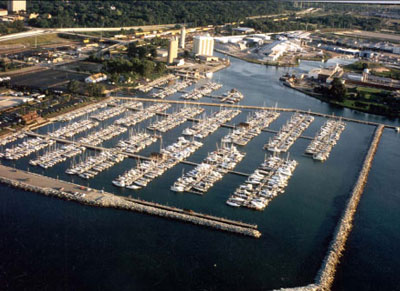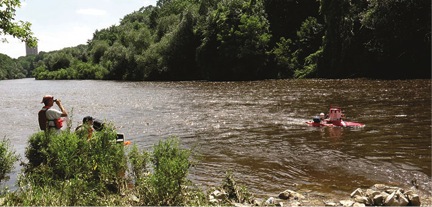
Waukegan Harbor. Photo: Environmental Protection Agency.
An interactive map showcases successful federal restoration projects in the Great Lakes states, including projects from the $475 million Great Lakes Restoration Initiative.
The map is produced by the Healing Our Waters-Great Lakes Coalition, an association of more than 120 environmental and conservation groups.
Here’s a quick look at what the coalition views as success stories in Illinois:
One success story is the cleanup of Waukegan Harbor. Dredging to remove 175,000 cubic yards of contaminated sediment began in 2012 and is scheduled to be complete in 2013.The project is one of the last steps to restore the harbor and redevelop Waukegan’s waterfront.
The $48 million project aims to reverse what has been called the “world’s worse PCB (polychlorinated biphenyl) mess,” according to the coalition. The pollution poisoned fish and wildlife, closed beaches and made the region a Great Lakes Area of Concern.
Federal officials hope to remove the harbor from their list of Great Lakes toxic hotspots by 2014. Chemists, toxicologists, biologists, dredge operators, truck drivers, wastewater treatment technicians and general laborers were employed at the project.
Aside from the success, there is plenty of other work in Illinois, including the widespread efforts to control the spread of the invasive Asian Carp.
The threat of Asian carp migrating through Illinois’ river systems and into Lake Michigan could damage the $7 billion Great Lakes fishing industry.

Scientists collecting data on Asian carp. Photo: U.S. Geological Survey.
The many efforts include programs to identify and track carp using genetic detection techniques and to test newer control technologies that feature water guns, attractants and fish toxicants
Check out how some genetic techniques are used in this video by the U.S. Fish and Wildlife Service:
Other work in progress includes the Great Lakes Fishery and Ecosystem Restoration program. Four projects authorized under the program seek to restore fisheries, ecosystems and the beneficial uses of Illinois’ natural resources.
“The benefits are numerous…removing a variety of invasive species, restoring fishery habitat, restoring rare dune and swale habitat, and increasing species richness of numerous habitat types providing migratory bird resting and feeding areas,” said Gene Fleming, chief of the Environmental Formulation and Analysis Section of the U.S. Army Corps of Engineer’s Chicago District.
One such project at Orland Park disabled 275 acres of drainage tile that has resulted in the return of over 50 acres of seasonal and year-round wetlands.
“After the wetlands (and) ponds were reestablished, over 30 new species of birds has been observed that were not observed in the area while it was used as farm land,” Fleming said.
The restoration projects help the Illinois economy according to a report by the Great Lakes Commission, an interstate public conservation agency.
Restoration helps protect the drinking water of $7 million Illinois residents and industries such as the $3.2 billion boating and fishing market, according to the commission. Projects may also contribute to the $13.3 billion in increased shoreline property values within the Chicago metro area.